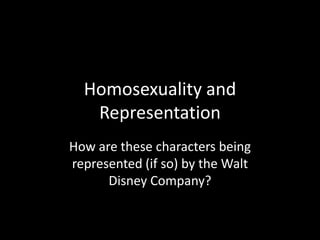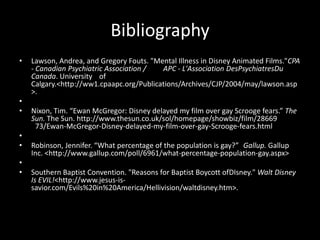Homosexuality and representation in disney
- 1. Homosexuality and RepresentationHow are these characters being represented (if so) by the Walt Disney Company?
- 2. Where are all the gay characters?
- 3. It would be fantastic to say how much I enjoyed watching Princess Veronica fall in love with Princess Michelle, or to sit down and watch a classic Disney love story unfold where Prince Charming had to fight off an evil dragon to save Prince David from the wicked witch…However, this doesn’t exist in the wonderful world of Disney
- 4. 1 out of 20 people (approx.)Provided by the U.S. 2000 Census Bureau
- 5. So why keep these characters hiding in the closet?Sending the “wrong” messagesEWAN MCGREGOR has hinted that Disney chiefs meddled with his new movie's release date - because of its gay content.Disney pushed it back “fearing kids wouldn’t accept JIM CAREY as a straight man in the studio’s remake of A Christmas Carol”."They didn't want kids thinking Ebenezer Scrooge was a bender.”
- 6. Homosexuality isn’t commercial? Although there are many people who purchase Disney products, how many are willing to spend money on homosexuality?
- 7. If Disney produces a gay-themed story – will it generate profit?
- 8. “Don’t blame Disney; blame society!” Arguing that Disney could easily produce more gay characters and themes – but their audiences just don’t want them. (Not necessarily)
- 9. There have been numerous gay-themed motion pictures produced in the last decade. Many of which have earned enormous profits and successes. Bad Publicity1984 – Michael Eisner becomes CEO of Walt Disney Company.Eisner brings forth a new meaning to Disney – trying to push boundaries and steer away from the classical.Stories are being created, as opposed to recreated. Moving from traditional European folktales to more diverse stories.1991 – Disney creates “Gay Days at Walt Disney World” (A gay pride event held ever year in Disney World Orlando, Florida in the first week of June.)The Lion King (1994) characters Timone & Pumba criticized by large number of Christian audiences for being a potential homosexual couple.
- 10. Bad Publicity (cont.)Eisner and his drift from regularity caused some uproar within Disney’s audiences.The Southern Baptist Convention, the largest Protestant Church in America with 16 million members, has challenged the Disney Empire over the “un-Christian and immoral material they are pumping into American homes”. Stating “it has become so obscene that Walt Disney would turn over in his grave if he knew what the evil Michael Eisner has done to the institution he created! ”Dallas, Texas. The 12,000 Baptist delegates voted overwhelmingly to launch a boycott of all Disney-owned companiesWhile Disney earned $21 million in 1996, its stock fell dramatically when the boycott was announced.
- 11. “Disney has abandoned traditional family values to promote the homosexual agenda. The time has come to stop patronizing any company that promotes immoral ideologies and practices.” – Rev. Roy Fisher, First Baptist ChurchFrom a managerial perspective, it is hard to ignore these high-strung opinions of your consumers. After all, you’re job is to keep your audiences happy – and in return they make you rich.
- 12. However, is Disney in the right by essentially putting these issues aside just to make an easy buck?
- 13. Decisions, decisions, decisions…At the end of the day, despite the attempts made by Disney to try and represent homosexuality as a topic of their concern – these ventures are bleak and meaningless; only adding insult to injury.Yes – Disney has made some effort towards solving the issue(s) of inequality with gays & lesbians within their company (with a reported 40% of their employees being gay/lesbian; with extended company health coverage for live-in partners.)Yes – Disney has hired renowned lesbian producer Lauren Lloyd to help further develop female-oriented motion pictures.
- 14. But is this enough?While it’s excellent that Disney has made actions such as organizing “Gay Days at Disney Land” and hiring more homosexuals within the company – there is still no representation of any of this generosity within their films and products themselves.If the company has no problem hosting annual pride events, and even advertising in Out Magazine, there should be no reason why this lack of homosexuality and/or gay and lesbian characters is still a problem.
- 15. “Always let your conscious be your guide!”
- 16. Stigma Development in ChildrenUnderstanding the presentation of mental illness in Walt Disney Company motion pictures.A research project conducted by the Canadian Psychiatric Association
- 17. How are stigmas developed in children?Some studies have examined children’s labels for stereotypic attitudes about mental illness, obesity and the elderly. An important question is “how are our children acquiring these labels and attitudes, especially in the absence of direct exposure to these people in their everyday lives.”
- 18. One way may be through watching animated feature films, in which various characters are portrayed as mentally ill.-> Understanding the presentation of mental illness in children’s movies is important for 3 main reasons…
- 19. Exposure as child sets foundation for beliefs. Studies have shown that children’s exposure to TV and movies influences attitudes toward a wide range of social groups, that is, the elderly, persons with a mental disability, and persons with obesity. Therefore, repeated exposure to depictions of mental illness in movies likely influences children’s attitudes toward persons with a mental illness.Thus, children may learn labels referring to those with a mental illness (such as “crazy” or “nutty as a fruitcake”), potentially acquiring the negative connotations and stereotypes associated with such labels (for example, inferiority or dangerousness).It has been suggested that adults’ stereotypical beliefs about mental illness may have originally been acquired through media exposure in childhood.
- 20. Distorted representations of mentally ill persons are believed as the truth by young children.Early exposure to characters stereotypically depicted as mentally ill could cause the vicarious induction of fear and anxiety in young viewers, resulting in unconscious social distancing from these individuals.An example of this would be Disney’s portrayal of Quasimodo in The Hunchback of Notre Dame.Another example is the representation of Goofy as someone who’s lack of intelligence always seems to get him into trouble.
- 21. Negative consequences associated with stereotypical beliefsResearch has consistently demonstrated negative consequences associated with adults’ stereotypical beliefs about mental illness and persons with a mental illness. For example, research showing stigmatization and discrimination against those with a mental illness and public policy regarding mental health.
- 22. Method of AnalysisThe Walt Disney Company produced 40 full-length animated feature films between 1937 and 2001.All such films were included in the study, except for those without a consistent story line (for example, Fantasia & Fantasia 2000.)Thus,theyanalyzed a total of 34 films for content, and the prevalence of verbalizations about mental illness.
- 23. ResultsAtotal of 85% of Disney animated films contained references to characters with mental illness.More specifically, 21% of all principal characters were referred to as mentally ill (for instance, Maurice of Beauty and the Beast, Jafar of Aladdin, and Mrs Jumbo of Dumbo)
- 24. Results (cont.)First, the prevalence of verbal references to mental illness in animated films is considerably higher than that found in children’s TV programs available in Britain(46%) and other Western areas, including both non- verbal and verbal references.Second, prevalence of verbal references to mental illness in animated films is higher than the incidence of mental illness worldwide (9.5%)Therefore, children who watch animated films of the Walt Disney Company are exposed to a greater incidence of mental illness than is typically seen on TV and are exposed to a greater incidence of mental illness than they may experience in their everyday lives.
- 25. Results (cont.)The average number of mental illness references per film was 5.The 3 most prevalent words(in descending order) are “crazy,” “mad” or “madness,” and “nut” or “nutty.”These references were commonly employed to segregate, alienate, and denote the inferior status of the character(s) to which they referred—a finding consistent with the overwhelmingly negative portrayal of mental illness found in both children and adult media.
- 26. ExamplesIn Beauty and the Beast, the townspeople frequently refer to the Belle as an intellectual and her father, Maurice as mentally ill.Derogatory words are used to set apart and denigrate this character, implying that to be mentally ill is to be different in a negative and inferior way.As the film progresses, the frequency of these words aimed at Maurice increases, climaxing in a scene where he is chained and hauled off in a “lunacy wagon.”
- 27. Examples (cont.)The children watching could associate mental illness labels with people who are so frightening and dangerous that they must be chained and locked away from the rest of society.This emotional association may result in increased fear of persons with a mental illness, increased worries of possible harm, and an increase in distancing and avoidance of contact.This is consistent with research indicating that children fear and distrust persons with mental illness and try to maintain their social distance from them.
- 28. Examples (cont.)In The Lion King, the Hyenas are depicted as being mentally ill, as evidenced by their rolling eyes, their high-pitched hysterical laughter, and the antics of Ed (the “craziest” of them all), who at one point mistakenly gnaws on his own leg.As the film progresses, it is clear that the hyenas represent the lowest social group in the animal kingdom and that they are to be feared and avoided.Thus, these “mentally ill” characters represent an animated example of being feared, socially distanced, and (or) alienated and laughed at.
- 29. What does this all mean?In brief, young children who watch a range of Disney films during their developmental years are consistently exposed to animated characters who are referred to or labeled as mentally ill, often several times within each film.As a result of the repetition on the denigrating nature of the references, young viewers may learn to label and stereotype others using this terminology, thinking it appropriate and funny.They may learn negative emotional responses (such as fear and disrespect) through the negative portrayals of the characters.The popularity of these Disney films and the ability of children to repeatedly view them (for example, in the home and often with parents) suggests that animated films may have more impact than we expect.
- 30. BibliographyLawson, Andrea, and Gregory Fouts. "Mental Illness in Disney Animated Films."CPA - Canadian Psychiatric Association / APC - L'Association DesPsychiatresDu Canada. University of Calgary.<http://ww1.cpaapc.org/Publications/Archives/CJP/2004/may/lawson.asp>. Nixon, Tim. “Ewan McGregor: Disney delayed my film over gay Scrooge fears.” The Sun. The Sun. http://www.thesun.co.uk/sol/homepage/showbiz/film/28669 73/Ewan-McGregor-Disney-delayed-my-film-over-gay- Scrooge-fears.html Robinson, Jennifer. “What percentage of the population is gay?” Gallup. Gallup Inc. <http://www.gallup.com/poll/6961/what-percentage-population-gay.aspx> Southern Baptist Convention. "Reasons for Baptist Boycott ofDIsney." Walt Disney Is EVIL! <http://www.jesus-is-savior.com/Evils%20in%20America/Hellivision/waltdisney.htm>.



























